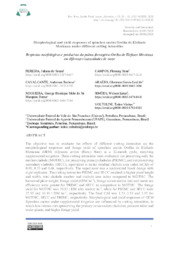Morphological and yield responses of spineless cactus Orelha de Elefante Mexicana under different cutting intensities.
Morphological and yield responses of spineless cactus Orelha de Elefante Mexicana under different cutting intensities.
Author(s): PEREIRA, J. de S.; CAMPOS, F. S.; CAVALCANTE, A. B.; ARAUJO, G. G. L. de; NOGUEIRA, G. H. M. de S. M. F.; SIMOES, W. L.; VOLTOLINI, T. V.
Summary: The objective was to evaluate the effects of different cutting intensities on the morphological responses and forage yield of spineless cactus Orelha de Elefante Mexicana (OEM) (Opuntia stricta (Haw.) Haw) in a 12-month cycle, receiving supplemental irrigation. Three cutting intensities were evaluated: cut preserving only the mother cladode (MOTHC), cut preserving primary cladodes (PRIMC), and cut preserving secondary cladodes (SECC), equivalent to initial residual cladode area index (rCAI) of 0.08, 0.33 and 0.69, respectively. The experiment was a randomized block design with eight replicates. The cutting intensities PRIMC and SECC resulted in higher plant height and width, total cladode number and cladode area index compared to MOTHC. The harvested plant weight, forage yield (t DM ha-1), forage accumulation rate and water use efficiency were greater for PRIMC and SECC in comparison to MOTHC. The forage yield for MOTHC was 20.92 t DM (dry matter) ha-1, while for PRIMC and SECC were 37.55 and 33.18 t DM ha-1, respectively. The final CAI was 1.23, 2.53 and 3.55 for MOTHC, SECC and PRIMC, respectively. Morphological and yield responses of OEM Spineless cactus under supplemental irrigation are influenced by cutting intensities, in which less intense cuts (preserving the primary or secondary cladodes) promote taller and wider plants, and higher forage yield.
Publication year: 2020
Types of publication: Journal article
Unit: Embrapa Semi-arid Region
Observation
Some of Embrapa's publications are published as ePub files. To read them, use or download one of the following free software options to your computer or mobile device. Android: Google Play Books; IOS: iBooks; Windows and Linux: Calibre.
Access other publications
Access the Agricultural Research Database (BDPA) to consult Embrapa's full library collection and records.
Visit Embrapa Bookstore to purchase books and other publications sold by Embrapa.

